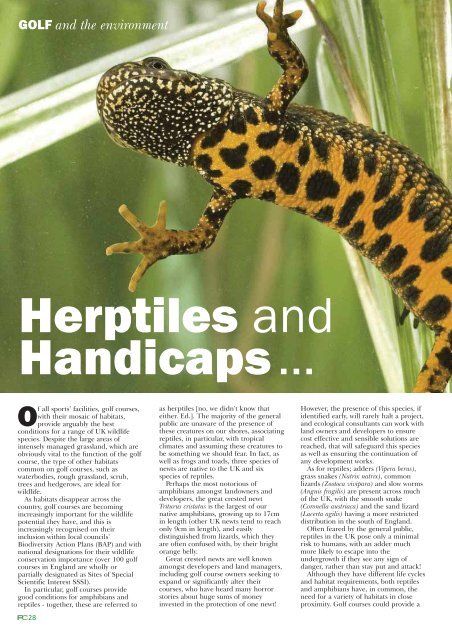Marshalling his troops - Pitchcare
Marshalling his troops - Pitchcare
Marshalling his troops - Pitchcare
You also want an ePaper? Increase the reach of your titles
YUMPU automatically turns print PDFs into web optimized ePapers that Google loves.
GOLF and the environment<br />
Herptiles and<br />
Handicaps...<br />
Of all sports’ facilities, golf courses,<br />
with their mosaic of habitats,<br />
provide arguably the best<br />
conditions for a range of UK wildlife<br />
species. Despite the large areas of<br />
intensely managed grassland, which are<br />
obviously vital to the function of the golf<br />
course, the type of other habitats<br />
common on golf courses, such as<br />
waterbodies, rough grassland, scrub,<br />
trees and hedgerows, are ideal for<br />
wildlife.<br />
As habitats disappear across the<br />
country, golf courses are becoming<br />
increasingly important for the wildlife<br />
potential they have, and t<strong>his</strong> is<br />
increasingly recognised on their<br />
inclusion within local councils’<br />
Biodiversity Action Plans (BAP) and with<br />
national designations for their wildlife<br />
conservation importance (over 100 golf<br />
courses in England are wholly or<br />
partially designated as Sites of Special<br />
Scientific Interest SSSI).<br />
In particular, golf courses provide<br />
good conditions for amphibians and<br />
reptiles - together, these are referred to<br />
28<br />
as herptiles [no, we didn’t know that<br />
either. Ed.]. The majority of the general<br />
public are unaware of the presence of<br />
these creatures on our shores, associating<br />
reptiles, in particular, with tropical<br />
climates and assuming these creatures to<br />
be something we should fear. In fact, as<br />
well as frogs and toads, three species of<br />
newts are native to the UK and six<br />
species of reptiles.<br />
Perhaps the most notorious of<br />
amphibians amongst landowners and<br />
developers, the great crested newt<br />
Triturus cristatus is the largest of our<br />
native amphibians, growing up to 17cm<br />
in length (other UK newts tend to reach<br />
only 9cm in length), and easily<br />
distinguished from lizards, which they<br />
are often confused with, by their bright<br />
orange belly.<br />
Great crested newts are well known<br />
amongst developers and land managers,<br />
including golf course owners seeking to<br />
expand or significantly alter their<br />
courses, who have heard many horror<br />
stories about huge sums of money<br />
invested in the protection of one newt!<br />
However, the presence of t<strong>his</strong> species, if<br />
identified early, will rarely halt a project,<br />
and ecological consultants can work with<br />
land owners and developers to ensure<br />
cost effective and sensible solutions are<br />
reached, that will safeguard t<strong>his</strong> species<br />
as well as ensuring the continuation of<br />
any development works.<br />
As for reptiles; adders (Vipera berus),<br />
grass snakes (Natrix natrix), common<br />
lizards (Zootoca vivipara) and slow worms<br />
(Anguis fragilis) are present across much<br />
of the UK, with the smooth snake<br />
(Coronella austriaca) and the sand lizard<br />
(Lacerta agilis) having a more restricted<br />
distribution in the south of England.<br />
Often feared by the general public,<br />
reptiles in the UK pose only a minimal<br />
risk to humans, with an adder much<br />
more likely to escape into the<br />
undergrowth if they see any sign of<br />
danger, rather than stay put and attack!<br />
Although they have different life cycles<br />
and habitat requirements, both reptiles<br />
and amphibians have, in common, the<br />
need for a variety of habitats in close<br />
proximity. Golf courses could provide a


